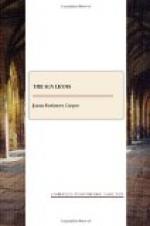Had there been an impartial judge present, he might have differed from both sets of critics. Such a person would have seen that one of these schooners excelled in this quality, while the other had an equal advantage in another. In this way, by running through the list of properties that are desirable in a ship, he would, most probably, have come to the conclusion that there was not much to choose between the two vessels; but, that each had been constructed with an intelligent regard to the particular service in which she was about to be employed, and both were handled by men who knew perfectly well how to take care of craft of that description.
The wind gradually increased in strength, and sail was shortened in the schooners, until each was finally brought down to a close-reefed foresail. This would have been heaving the vessels to, had they not been kept a little off, in order to force them through the water. To lie-to, in perfection, some after-sail might have been required; but neither master saw a necessity, as yet, of remaining stationary. It was thought better to wade along some two knots, than to be pitching and lurching with nothing but a drift, or leeward set. In this, both masters were probably right, and found their vessels farther to windward in the end, than if they had endeavoured to hold their own, by lying-to. The great difficulty they had to contend with in keeping a little off, was the danger of seas coming on board; but, as yet, the ocean was not sufficiently aroused to make this very hazardous, and both schooners, having no real cargoes, were light and buoyant, and floated dry. Had they encountered the sea there was, with full freights in their holds, it might have been imprudent to expose them even to this remote chance of having their decks swept. Water comes aboard of small vessels, almost without an exception, in head winds and seas; though the contrivances of modern naval architecture have provided defences that make merchant vessels, now, infinitely more comfortable, in this respect, than they were at the period of which we are writing.




